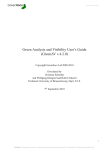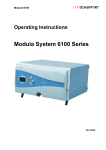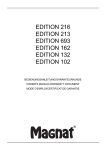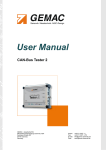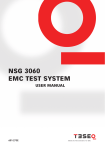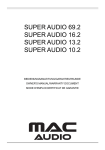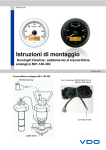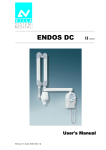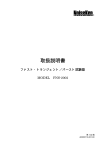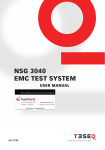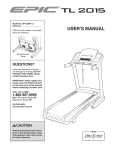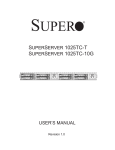Download 601-210D - NSG 3025 User Manual english.indd
Transcript
1 NSG 3025 Burst generator User manual 601-210D NSG 3025 Burst generator User Manual NSG 3025 Burst Generator Contents 1 Safety advice 1.1General 1.2 Installation guidlines 1.3 Test execution 1.4 Dangers concerning the generator 1.5 Dangers concerning the EUT 1.6 Applicable safety standards 2 Unpacking, storage and transport 2.1General 2.2 Storage and transport 2.3Unpacking 3 Description of the instrument 3.1Introduction 3.2 Operating elements 3.2.1 Front panel 3.2.2 Rear panel 4 Installation and power supply 4.1Installation 4.2Location 4.3 Power supply 4.3.1 Instrument power supply 4.3.2 EUT power supply 4.4 Front panel connections 4.4.1 Coupling via the pulse output 4.4.2 Coupling clamp 4.4.3 Verifying the pulse output 4.5 EUT connection 4.6 Connections to rear panel 7 7 8 9 10 10 11 12 12 12 13 14 14 15 15 17 18 18 18 19 19 20 21 21 21 22 22 23 4.6.1 EUT supply 4.6.2 Remote control port (RS 232) 4.6.3 Control input for external CDN 4.6.4 Interlock (Optional) 4.6.5 Trigger input and output 4.6.6 EUT FAIL input 4.7Mounting 5 Block diagram 5.1 HV circuit and HV pulse generator 5.2 Coupling network 6Operating 6.1 Local operation 6.2 Operating states 6.3 Main menu 6.4 Options menu 6.5 Ramping menu 6.6 About menu 6.7 Validity range of parameter setting 6.8 System messages 7 Function check 7.1Controls 7.2 Pulse generator 7.3 Remote control 7.4 Mains coupling 7.5Faults 7.6 Trouble shooting 8Standards 8.1 Safety measures as per VDE 0104 8.2 Typical applications and standards 8.3 Pulse verification with CAS 3025 9Maintenance 9.1Service 9.2 External care 10 Replacement parts 11Disposal 12 Technical data 12.1 Electrical specifications 23 23 24 27 31 31 32 34 34 35 36 36 38 39 40 42 45 46 46 48 48 49 49 49 50 51 53 53 54 56 57 57 58 59 60 61 61 12.2Dimensions 12.3 Environmental conditions 13 Ordering information 13.1Options 14 Definitions 14.1Abbreviations 14.2Standards 15Addresses 64 64 65 65 66 66 67 68 5 1 Safety Advice The generator and its accessories work at high voltage. Improper or careless handling can be fatal! These operating instructions form an integral part of the equipment and must be available to the operating personnel at all times. All the safety instructions and advice notes are to be observed. Neither Teseq AG nor any of the subsidiary sales organisations can accept any responsibility for personal, material or consequential injury, loss or damage that may result from improper use of the equipment or accessories. 1.1 General Use of the generator is restricted to authorised and trained specialists. The generator is to be used only for the purposes set down by the manufacturer. The construction of the unit renders it unsuitable for use in an explosive atmosphere. Persons fitted with a heart pacemaker must not operate the instrument nor approach the test rig while it is in operation. 7 8 Only approved accessory items, connectors, adapters, etc. are to be used to ensure safe operation. Advisory measures are described in these instructions as follows: WARNING: For potential dangers that could result in serious injury or death. CAUTION: For potential dangers or mishandling that could cause light injuries or material damage. 1.2 Installation guidelines The instrument conforms to protection class 1, but with an increased leakage current. Local installation regulations must be respected to ensure safe flow of leakage currents. Operation without a protective earth connection is forbidden! Two independent protective earth connections are necessary (instrument and EUT* supply) connected back to the local permanent installation or to a fixed, permanent protective earth conductor. Operate the equipment only in dry surroundings. Any condensation that occurs must be allowed to evaporate before putting the equipment into operation. Do not exceed the permissible ambient temperature, humidity or altitude. Use only legally approved connectors and accessory items. Ensure that a reliable return path for the interference current is provided between the EUT and the generator. The reference ground plane and the earth connections to the instruments as described in the relevant test standard serve this purpose well. *) Explanation see chapter «Definitions» NSG 3025 Burst Generator The instruments must generally not be opened. This may only be undertaken by a qualified specialist whereby any precaution measures as per this manual are to be observed. Since the equipment generally works with two independent power supplies for the generator and the EUT, the instrument must first be disconnected from both sources before any changes in the test set-up are made. Besides the mains supply itself, certain instruments or parts thereof, also operate at high voltages which are not provided with any internal form of extra protection against being touched. 1.3 Test execution The test area must be so organised that no unauthorised persons have access during execution of a test. If the safety contact (optional interlock) is used as a means of access control to the test zone (e.g. Faraday cage), then an additional contact in series is necessary to provide protection for parts of the EUT that are in danger of being touched. EUTs, together with their accessories and cables, are to be considered as being live during a test. The test generator must be stopped and the EUT supply interrupted before any work is carried out on the EUT. This can be implemented by opening the interlock circuit, but depends on the type of generator in use. The EUT is to be tested only in a protective cage or under a hood which provides protection against electric shock and all manner of other dangers pertaining to the particular EUT (see Dangers concerning the EUT). The safety instructions concerning all the instruments and associated equipment involved in the test rig are to be observed. The configuration of the test rig is to be strictly in compliance with the methods described in the relevant standard to ensure that the test is executed in a standard-conform manner. 9 10 1.4 Dangers concerning the generator Local burning, arcing, ignition of explosive gases. Danger from the resultant EUT supply current caused by a flashover or breakdown resulting from the superimposed high voltage effects. Disturbance of unrelated electronics, telecommunications, navigational systems and heart pacemakers through unnoticed radiation of high frequency energy. In most test rigs the interference voltage is superimposed also on the protective earth conductor of the EUT in accordance with the requirements of the test standard. Earth contacts or pins (e.g. in German and French connectors) as well as the EUT earth itself can hence be at a dangerous to touch voltage. The screws, too, in certain connectors are linked to the protective earth. 1.5 Dangers concerning the EUT EUTs are often simply functional samples that have not previously been subjected to any safety tests. It might therefore happen that the EUT could get damaged by internal overloads caused by disturbed control electronics or it may even start to burn. As soon as the EUT shows signs of being disrupted the test should be stopped and the power to the EUT switched off. Internal disruption of the electronics can result in the interference voltage or the EUT supply voltage being present on the EUTs housing. Electrical breakdown or arcing from and in plugged connections that are overstressed voltagewise during the test. NSG 3025 Burst Generator Explosion of electronic components with fire or fragmentation as a result of the energy dissipated, e.g. from the resultant supply current or ignition of vaporised plastics materials. Faulty behaviour by the EUT, e.g. robot device strikes out, temperature controller fails, etc. 1.6 Applicable safety standards Development and manufacture is in compliance with ISO 9001. The equipment conforms to the safety requirements of IEC 1010-1 / EN 61010-1 (Safety requirements for electrical equipment for measurement, control and laboratory use). The switching power supply conforms to IEC 950. All mains driven types of generators are equipped for high voltage working safety in accordance with VDE 0104. Details see chapter «Standards». The interference immunity has been tested in conformity with EN 50 082-1. It is the user›s responsibility to ensure that the test set up does not emit excessive radiation that might affect other equipment. The generator itself does not produce excessive radiation, however applying burst-pulses to an EUT may cause EUTs and its cables to start radiating EMI. The method recommended by standardisation bodies to prevent unwanted emission is to operate the test rig in a Faraday cage. 11 12 2Unpacking, storage and transport 2.1 General Do not throw anything away! Packaging either: Keep for despatching the instrument to the calibration service Return to the relevant sales outlet Dispose of in an environmentally friendly manner, thus: Packaging materials: Card box: cardboard Padding: CFC-free polystyrene foam Plastic bags: polyethylene If large temperature difference has been experienced, allow some hours to elapse to permit the temperature to stabilise before opening the package. Avoid the possibility of condensation occurring! 2.2 Storage and transport Do not stack, neither packaged nor out of the packing. Do not put upside down, arrows on the packaging must always point upwards. Protect from dampness, heat, cold and rain. Do not throw. Do not put anything on the instrument or on the packaging-respectively. Despatch only in the original packaging or its equivalent. NSG 3025 Burst Generator 2.3 Unpacking Is the packaging intact? If NO g complain to transportation company Are all the packages present and correct? If NO g complain to transportation company Open the packaging, remove the accessories. Lift the instrument out of the packaging. Are the instrument and the accessories intact? If NO g complain to transportation company Are the contents of the package complete according to the picking list? If NO g complain to sales outlet Keep the operating instructions with the instrument. (Copies can be ordered from the sales outlet) Save the packaging. (Inform the sales outlet in advance if you intend to return the package material.) ATTENTION: An electrical function check is only permissible and possible by a trained specialist. 13 14 3 description of the instrument 3.1 Introduction This top class EMC test instrument for burst or electrical fast transient tests provides an efficient means to perform functional examinations on all types of electronic equipment to determine their susceptibility to electromagnetic disturbances. The disturbance generator comes with a built-in 1-phase coupler (CDN) for max. 16 A. Optional CDNs for EUTs up to 100 A/phase and coupling clamps are available. The NSG 3025 is the best choice for executing interference immunity tests with burst pulses called for in IEC/EN 61000-4-4 and by related product standards. Thanks to special flexibility with regard to parameter setting the generator is also most suitable for complex applications in the field of research and development. Besides, its easy handling facilitates mobile use for tests on large machinery and installations on site. The instrument generates bursts of interference pulses simulating those produced by inductively loaded switches. Such pulses, with their very fast rise times, have a spectrum that extends to over 300 MHz. It may occur where currents are switched by means of electromechanical devices, e.g. with motors, circuit breakers and relays, fluorescent lamps, etc. – Burst tests are hence demanded by practically all the relevant standards for the testing of electronic equipment in addition to testing with electrostatic discharges using an ESD simulator such as e.g. a model NSG 435. § Before you can sign your electronic products with the legally required CE symbol within the EC you must have performed an EMC test in conformity with EN/IEC 61000-6-1 and -2 or equivalent product standards. NSG 3025 Burst Generator 3.2 Operating elements 15 3.2.1 Front panel 1 2 8 11 7 FAST TRANSIENT BURST GENERATOR NSG 3025 3 12 4 6 5 9 10 1. LCD display Shows set values and system messages. 2. Function keys Their active function is shown in the display. 3. «Enter» key Terminates each input and activates the selected function. Return to the basic menu. 4. «Stop» key Stops the current test, switches the high voltage off and resets the timer for the test time. The green «stop» LED indicates the ‹stop› state. 5. «Pause» key Puts the current test on hold and stops the timer for the test time without resetting it. The HV is kept on and the external trigger enabled for single spikes. The HV switches off if no further function is executed within a period of 2 minutes. Orange «pause» LED indicates the ‹pause› state. 16 6. «Run» key 7. «Up/down» key 8. HV socket 9. Earth connection 10. EUT connection 11. LED «pulse» 12. Handle Switches the high voltage on and, once the set level has been attained, starts the test running for the duration defined by the «Test time» timer. Red «Run» LED indicates the ‹run› state. To alter the selected parameter. HV-OUT for direct pulse output to a coupling device and for calibration of the pulse characteristics. Return path from the ground reference plane. With decoupling from the EUT power source. PE is connected to ground by an inductor. The LED flashes for each generated pulse. Adjustable handle NSG 3025 Burst Generator 3.2.2 Rear panel 17 2 10 6 8 11 7 5 CAUTION To prevent electric shock connect the protective Earth conductor of the mains cable and the EUT supply to a solid Earth. Remove the mains cable before exchanging a fuse. Replace fuse only with the Specified type and rating. EUT AC INPUT 200 VAC Max. / 1GA Max. SWITCHED POWER CAUTION A test rig incorporating this instrument can radiate strong electromagnetic interference. Operation only permissidle in a closed faraday cage. WARNING Lethal danger trough high voltage do not oplin singl there are no userserviceable parts inside. Service work to be carried out only servie workt to be Carried out Only by afactorytrained specialist. 12 1. 2. 3. 4. 5. 6. 7. 3 9 4 1 Cable support Fan, air outlet Ventilation slots Mains switch Mains input for generator power supply Voltage selector with fuse for the generator supply D-sub 9-pin connector with auxiliary signals such as EUT-FAIL, PULSE TRIGGER and EXTERNAL TRIGGER 8. D-sub 25-pin connector, remote control RS 232, DCE, without HW control lines 9600 baud, 8-bit, even parity, 2 stop bit 9. D-sub 37-pin connector for controlling an external coupling device such as CDN 131-151 or CDN 133-153 10.Earth screw, for protective earth connection 11. EUT supply input 12.Connectors for interlock (Option) 18 4Installation and power supply 4.1 Installation Apart from the power connections, no further installation is necessary for manual operation of the instrument. The test rig itself must, however, be configured precisely in accordance with the relevant standard and test plan to enable standard-conform burst tests to be carried out. An earth reference plane of at least 1 m² is necessary while observing a minimum spacing from nearby walls of 0.5 m. 4.2 Location A screened room (Faraday cage) is the only location that should be considered for running the generator. Only trained, authorised personnel without a heart pacemaker should be granted access. The ambient conditions should be within the specifications of all the equipment involved. An environment as per IEC 68-1-(1988) is recommended: Ambient temperature: 15°C to 35°C Relative humidity: 25% to 75% Air pressure: 86 kPa to 106 kPa The ventilation slots on the instrument must not be blocked. The free space available should be large enough so that a tidy, standard-conform test rig can be arranged for all the expected types of EUTs, thereby providing at least 0.5m distance from any walls. NSG 3025 Burst Generator 4.3 Power supply The NSG 3025 has two independent power supply inputs: (1) Instrument supply via an IEC 320/IV equipment connector (2) EUT supply via an IEC 320/IV equipment connector (250 V/16 A) WARNING: The EUT supply produces earth leakage currents of up to 5 mA with 50/60 Hz supplies and up to about 15 mA with 400 Hz/120 V supply because of the coupling capacitors and filter (CDN) involved. The NSG 3025 must hence be efficiently earthed. One of the following additional protective measures might be necessary, depending on local regulations: Permanently connected additional earth conductor. Both power feeds as well as the earth lines to be connected separately to the building’s fixed installation. CAUTION: RCD circuit breakers can be triggered by the EUT supply. This may happen while the instrument and/ or the EUT is in operation. 4.3.1 Instrument power supply The device can be connected to a 100, 115, 220, 230 or 240 Volt, 50/60 Hz mains outlet. The voltage selector is to be set to suit the local conditions (for 100/115 V set to 115 V and for 220–240 V set to 230 V). Permissible mains voltage tolerances: 100 and 220 V -10% +15% 115 and 230 V ± 10% 240 V+6% -15% It is imperative that a protective earth connection is also provided. 19 20 4.3.2 EUT power supply CAUTION: A suitable fuse must be provided separately in the external installation. Maximum permissible nominal rating for the fuse, according to the CDN specification: 250 V/16 A slow (50/60 Hz) for DC applications. Special fuses required. We recommend a permanent connection to a junction box with a fuse. This box can also provide a protective earth connection for the reference ground plane as well as outlet sockets for the instrument supply (1) and further equipment. CAUTION: Electronic components, frequency inverters and dc power supply units can be disrupted or damaged by the feedback effects of the burst signal. The link between the protective earth connection and a protective earth conductor is to be established before any other connections are made. Rear panel: EUT Input (male) N L PE NSG 3025 Burst Generator Front panel: EUT Output (female) N L PE 4.4 Front panel connections 4.4.1 Coupling via the pulse output CAUTION: Use only accessories which are designed for burst pulses up to 4.8 kV. Do not set the burst voltage higher than the breakdown voltage rating of the connected parts. 4.4.2 Coupling clamp If the burst interference is to be injected into signal lines by means of a capacitive coupling clamp same is to be plugged into the «pulse output» of the NSG 3025. The coupling clamp type CDN 8014, which is available as an accessory, is constructed in conformity with the requirements of IEC 61000-4-4. The CDN 8015 is equipped with an interlock switch for additional touch prevention which forces the NSG 3025 into the «stop» state if the clamp is opened. Select «EXT» in the coupling menu to feed the burst pulses to the coupling clamp. This automatically de-selects any other line coupling. NOTE: Teseq recommends powering the EUT through the integral CDN even when working with a coupling clamp. The EUT power supply is thereby still fed through the decoupling circuit and is hence connected to a reproducible source impedance. Any tendency for interference currents to creep back to the mains supply will be prevented by the mains filter in the CDN. 21 22 4.4.3 Verifying the pulse output The best way to verify the NSG 3025 is the use of the verification set CAS 3025. It has been specially designed for periodic pulse characteristic verifications, fully compliant to requirements of IEC / EN 61000-4-4: Ed 2.0 (2004) and latest amendments 2006/2007. It Includes one each 50 Ω and 1 kΩ HV load. Further details see paragr. 8: Pulse verification with CAS 3025. 4.5 EUT connection The NSG 3025 is equipped with an integral coupling network (CDN) to super – impose burst spikes on a single phase supply. The supply is switched by two relay contacts (L and N). This relay is actuated by the control circuitry in series with a supplementary hardware contact on the interlock system (Option). WARNING: Remote control: The supply can be switched on by the software (Remote). Potential-free conditions can only be assured, if: EUT power is off Interlock (Option) is open The NSG 3025 is switched off CAUTION: It is essential to use good quality, well mounted plugs since otherwise the necessary breakdown and arcing strengths might not be achieved amongst other problems. A burst voltage of 4.8 kV can cause a breakdown or arc across normal mains insulation. For safety tests, the EUT has to be connected via the IEC plug. The mode of coupling must be in conformity with the relevant standard. There are standards in existence that only ever subject one line to the interference signal and others that superimpose the signal on all the lines simultaneously. Any mode of coupling can be freely chosen with the NSG 3025. NSG 3025 Burst Generator 4.6 Connections to rear panel 23 4.6.1 EUT supply It is to be protected by a fuse ahead of the generator to suit the user’s application but with a rating that does not exceed the nominal current rating of 16 Amps. A temperature monitoring facility supervises the decoupling chokes of external CDNs (automatic Teseq models). Should this be triggered the EUT supply shall be switched off and the display shows INFO 114. 4.6.2 Remote control port (RS 232) Remote control from a computer is achieved through the RS 232 port. Since the primary function of the NSG 3025 is the generation of high energy interference pulses, any electrically connected interface should preferably work with an optical link to prevent EMC problems or even destruction occurring. Such an opto-link also enables the computer to be operated outside the Faraday cage. Opto-link modules are available from Teseq as accessories. The interface port is configured as follows: Baud rate: 9600 Parity:even Data-bits:8 Stop-bits:2 XON/XOFF Mode:DCE Pin-out: Pin 1 Pin 2 Pin 3 Pin 7 Pin 18 Pin 25 Protective ground Input (Rx) Output (Tx) Signal ground +12 V -12 V 24 Remote control A number of control software possibilities may be considered: 1 Teseq program WIN 3025: This is a complete, comprehensive, «ready-to-work» Windows based package which offers the possibility to store whole control sequences, ramping functions and result logging. 2 Application with standard programming environments for measuring instruments: Programming environments that may be considered are VEE TM from hp as well as LabWindowsTM from National Instruments. 4.6.3 Control input for external CDN The 37-pin sub-D socket contains all the necessary signals which are needed to control an external CDN. For burst tests in combination with surge and/or higher EUT currents (1-ph/3-ph) Teseq offers coupler models CDN 131/151 (1x 25 A), CDN 133/153 (3x 25 A) or CDN 163 (3x 100 A). For automatic CDNs a system interlock option INA 3025 and adapter INA 3026 are provided. Connections and pin configuration (37-way): Outputs: Signal type: Inputs: Following outputs are available K0-K4 for selection of the required coupling mode EUT_POW for controlling the power switch of the EUT supply WL_GRN equipment ready (software signal) TTL/CMOS compatible Active = high = 5 V Internal impedance 1 kΩ Following inputs are available: CDN temperature control (supervision of limiting value) CDN single phase External limitation of burst voltage setting range NSG 3025 Burst Generator Pin Signal Description 1 NC – 2 GND Connection to ground via choke 3 EUT_POW Sets EUT power on/off 4 K4 Coupling to PE, external CDN 5 K3 Coupling to L1, external CDN 6 K2 Coupling to N, external CDN 7 K1 Coupling to L2, external CDN 8 K0 Coupling to L3, external CDN 9 WL_GRN Sets warning lamps green/red 10 to 15 16 NC V1PH – External CDN: Selection of phases 17 25 High (5 V) = PE, N, L1 V3KV Low (0 V) = PE, N, L1, L2, L3 External CDN: Voltage limitation (see pin 35) TEMP Low (0 V) = inactive External CDN: Temp. overload High (5 V) = active 18 High (5 V) = active 19 20 GND NC Low (0 V) = inactive Connection to ground via choke – 21 GND Connection to ground via choke 22 to 34 35 NC V2KV – External CDN: Voltage limitation (see pin 17) 36 NC – 37 GND Connection to ground via choke High (5V) = active Low (0V) = inactive 26 Pin assignment 19 1 37 20 The input that results in the most sever limitation on the operation of the instrument, whether internal or external, always carries the highest priority. The CDN overheat input will prevent the EUT supply being switched on and shall be indicated by a system message. Activating the V1PH input (+5 V) has the effect of excluding the setting possibilities for L2 and L3 (for external 1-phase CDN). The maximum possible setting for the burst voltage can be reduced to 2 kV or 3 kV resp. by means of the voltage limitation facility inputs V2KV and V3KV (activation with +5 V). The voltage limitation facility is used for connection systems whose insulation is not suitable for the full burst voltage. The inputs can also be used as an external limiting device to protect the EUT. The following table shows the possible stages of voltage limitation: Maximum voltage Voltage Voltage 4800 V limitation 2 0 limitation 3 0 4500 V 0 1 1500 V 1 0 500 V 1 1 0 = Low = 0 V, 1 = High = 5 V NSG 3025 Burst Generator 4.6.4 Interlock (Optional) The NSG 3025 has an integral Interlock system in keeping with the kind of safety standard expected of a high voltage test instrument. If there is no Interlock installed, it is possible to up-grade the unit by your sales office. This system has the following functions: 1 Input for external monitoring, e.g. from special coupling networks and access control restrictions. 2 Emergency off switch opens the Interlock circuit (High voltage and EUT power). 3 Operating mode: The NSG 3025 cannot be switched to «run» or «pause» if the Interlock circuit is not closed. The «stop» function is activated if the Interlock circuit is opened while the generator is in the RUN state. 4 EUT-Power: The EUT power supply cannot be switched on if the interlock circuit is not closed. The EUT supply is switched off if the interlock circuit is opened while the supply is switched on. 5 Warning lamps: The green lamp is switched off and the red one on when the interlock circuit is closed. 6 Display: An open interlock circuit is shown on the display by an open switch symbol. 7 Status messages to the remote control computer. 8 Interlock output for other system equipment. The interlock system for all the equipment in the ProfLine range has the same configuration and hence numerous items can be successfully connected together. 27 28 Each instrument is equipped with two 15-pin connectors which serve as the Interlock input and output respectively. The Interlock circuit must always be terminated at both ends with the relevant conductors being looped through the various safety contacts in the system. This is achieved automatically when using original Teseq accessories by making the connections to the Interlock connectors with 15-way standard cables wired on a 1:1 basis. An arbitrary number of instruments and/or accessory devices can be incorporated in the safety concept. The high voltage and the EUT supply are only enabled if the safety conditions are fulfilled at every unit that is connected (emergency stop button unlocked, safety circuit closed, etc.) The interlock function must be implemented for the control of warning lamps to comply with VDE 0104. Once the Interlock circuit is closed, the instruments are able to be switched on and the red lamp lights up. If an instrument is to be used without an external interlock contact then the two terminating connectors supplied must be inserted. Signal levels: Voltage 48 VDC max. Current 20 mA min. /1 A max. Connector: 15-pin sub-D socket Max. permissible cable length: 3 m each, screened (safe operation is guaranteed up to 10 m) Actuation is via potential-free switch contacts. All signals are active LOW, i.e. switched to GND. The pin-out at the interlock input and output connectors are identical. All the pins are individually interlinked whereby the internal connection between the two pins nr. 3 shall be interrupted by the emergency stop button or by the internal interlock facility when either one is activated. NSG 3025 Burst Generator PinFunction 1 GND, 0V 2 NC, linked to the other interlock connector 3 Interlock input/output (internal switch) 4 NC, linked to the other interlock connector 5 Interlock status (triggers the interlock function in the instrument and switches the relay if + 12 V to + 48 V 6 to 8 NC, linked to the other interlock connector 9 Switches warning lamps and peripherals active as soon as the NSG 3025 is switched from standby to ON) 10 to 15 NC, linked to the other interlock connector Housing Screen connected to ground 8 15-pin connector 1 15 9 NSG 3025 Termination 1 1 1 Termination 2 1 1 15 15 15 15 Rear view Circuit diagram of the interlock system S: External safety switch (e.g. test hood, door-switch, emergency button, etc.) 29 30 The safety contacts must be connected in series when several access safety barriers are necessary. An open contact or an input raised to more than 1.5 V is enough to inhibit the instrument. in 1 GND out 9 1 WL SELECT INT S1 INT S1 INT S2 INT RESET 15 8 15 8 EUT power relay EUT Power on HV on supply Emergency off Interlock relay Internal circuit diagram of the interlock NSG 3025 Burst Generator µP recognition 4.6.5 Trigger input and output Trigger input: The EXT TRIGGER input is only active when the instrument is in the PAUSE mode. The external trigger signal causes a burst package to be generated. The specification of the package are given in the display. Applications by user control: Special modulation of pulse packages Synchronisation of pulse packages by an external signal Simulation of noise by pulse modulated transmitters (digital phone) The minimum repetition rate is monitored from the controller. Trigger output: The TRIGGER OUTPUT signal serves to synchronise an oscilloscope. 4.6.6 EUT FAIL input The EUT-Fail Input signal serves to enable integrity monitoring of the device under test. The generator is set to the «stop» state when this input is activated and the system message «INFO 115» is displayed. The high voltage supply and the EUT Power will be switched off. The circuitry for recognising faulty EUT operation is dependent on the type of EUT involved in each case and is generally different for every test. A disturbancefree connection to the system must be provided. Signal type: TTL/CMOS compatible Active = high = 5 V Internal impedance 1 kΩ 31 32 Pin Signal Description 1 EUT_FAIL Input: Stops the NSG 3025 and switches the EUT off 2 EXT_TRIG 3 GND – 4 GND Connected to GND via choke 5 GND Connected to GND via choke 6 NC – 7 P_TRIGGER Output: Trigger for external equipment (CRO) 8 NC – 9 NC – Input: For external trigger signal. Generates 1 pulse package per edge (switch against GND, internal impedance 10 KΩ) 1 5 Connector pin-out 9 6 4.7 Mounting 1 EUT power connection: The mains cable for the EUT power connection is plugged and easily exchangeable. This is the safest method of connection. 2 HV capacitor: The power demanded by a 4.8 kV / 1 MHz spike sequence is delivered from the high voltage module via a large storage capacitor so that the whole pulse package remains within tolerances. 3 HV supply: A 50/60 Hz transformer with voltage switching on the primary side generates the supply voltage for the fly back converter which produces the high voltage. NSG 3025 Burst Generator 33 4 Power unit: The supply to the instrument’s electronics is provided by a switch mode power supply unit having an input voltage range from 85 V to 264 V. The power unit complies with the requirements of IEC 950. 5 UP/DOWN key: Permitting a simple, quick and quasi analogue setting of the test data. Most of the parameters can be continuously altered during operation as though by a potentiometer. 6 µP-control: The heart of the control circuitry is a state of the art, efficient 16-bit microprocessor in SMD technology. 7 A large, graphical LCD display panel with back-up illumination, shows the currently set values and enables local operation to be carried out rapidly and simply. 8 The small optimised EMC casing allows easy testing for both mobile use or in laboratory. 34 5block diagram Mains power Fuse Rectifier Thermo switch HV-Supply HV-SWITCH Coupling / Decoupling network INTERLOCK (Option) REMOTE PULSE OUTPUT CONTROLLER EXT. CDN EUT OUTPUT EUT INPUT USER Front panel 5.1 HV circuit and HV pulse generator S1 T1 D1 Z1 S3 Z4 S4 To +/- Interlock C1 HV-Control NSG 3025 Burst Generator S2 C2 Z3 CDN 5.2 Coupling network 35 L L PE PE 2 x C4 N EUT Input N 4 x C3 3 x L1 EUT Output S6 Pulse Output INTERLOCK Controller From pulse generator Legend to diagrams 5.1 and 5.2 T1 D1 C1 C2 C3 C4 S1 S2 S3 S4 S5 S6 Z1 Z2 Z3 L1 HV transformer HV rectifier HV energy storage Spike storage capacitor Coupling capacitor 10nF Reverse filter Interlock relay Safety discharge switch Fast solid state switch Polarity changeover switch Coupling relays, individually controllable EUT supply circuit relay Decoupling impedance Impedance for pulse width stabilisation Source impedance Decoupling chokes The CDN permits unsymmetric (single conductor) and asymmetric (all conductors together) coupling. 36 6Operating 6.1 Local operation This chapter presents an introduction into the multitude of possibilities that can be achieved with the NSG 3025. How to change parameters: Select the parameter by means of the soft-keys. The menu changes to the ramping menu. The value in the display will be shown in inverse mode. Change the value with the PULL UP / DOWN keys and confirm with ENTER. The value will show up normally and the menu changes back to the option menu. See also following diagram. If there is no confirmation, the original value shall be shown again and a message will be displayed. NSG 3025 Burst Generator 37 38 6.2 Operating states The instrument can be switched into the following states: STOP Interlock closed: The instrument is active, the display is in operation. The EUT supply can be switched on, all settings are possible. The HV is switched off. With «run» or «pause» the HV is switched on. The green LED nearby the STOP key is alight. Interlock open: High voltage and EUT power out are safely inhibited. It is not possible to switch on the EUT power or the High voltage. PAUSE High voltage is switched on, the instrument is waiting for external trigger pulse, the test time runs. This operating state is cancelled after 2 minutes (provided there was no triggering meanwhile), and the instrument goes into the «stop» state. The test time is reset to zero. RUN The instrument triggers burst pulses automatically according the parametter settings. The instrument switches itself into the «stop» state at the expiration of the test time. NSG 3025 Burst Generator 6.3 Main menu This menu is normally displayed and gives an overview of all parameters within the chosen fix setting «LEVEL» XY or in the «USER» program 1 to 99. LEVEL: Selects a test set-up. The Level definitions are according to IEC 61000-4-4 (P = Positive, N = Negative, A = Alternating). Only the PHASE and the coupling paths are changeable. LEVEL 1: LEVEL 2: LEVEL 3: LEVEL 4: USER: The USER settings are freely definable set-ups. All parameters (including rampings) of the generator will be stored. Ramping functions are only available in the USER set-ups. COUPLING: Selects the coupling path. INTernal means coupling the pulses to the internal CDN. EXTernal goes to the PULSE OUTPUT. If SEQuence is selected, the pulses will be coupled to each path for the selected test time. 500 V, 5 KHz, 300 ms, 75 Spikes 1000 V, 5 KHz, 300 ms, 75 Spikes 2000 V, 5 KHz, 300 ms, 75 Spikes 4000 V, 5 KHz, 300 ms, 75 Spikes 39 40 EUT P: Sets the EUT POWER on / off. Attention: If Interlock is open, it is not possible to switch the EUT POWER on! TIMER: Sets the test time. The generator stops when the test time has elapsed. In the Sequence mode the total test time is calculated thus: Coupling: INT SEQ L1, N, PE => Test time x 3 OPTIONS: Change to the Options menu. 6.4 Options menu In such a USER menu the parameters of the pulse generator can be modified. All parameters (without rampings) can also be changed during «run» or «pause». Change to the «main» menu with «enter». VOLTAGE: New setting of the pulse voltage amplitude. The polarity is selectable by a separate soft-key. If ALTernate is selected, the pulses are positive and then negative each for half of the test time. FREQ: New setting of the burst frequency. NSG 3025 Burst Generator PHASE: New setting of the phase angle. An EUT AC supply is necessary (EUT POWER on) for synchronous triggering. Synchronous triggering means: Burst package V EUT Mains t PHASE PHASE REP REP: New setting of the repetition time. The repetition time is defined from the first pulse of a package to the first pulse of the following one. If the duration time of the package is equal or higher than the repetition, continuous operation will occur. SPIKES: New setting of the number of spikes. The number of spikes also defines the duration time of a package: tDURATION = SPIKE x 1 FREQUENCY 41 42 6.5 Ramping menu Different rampings are selectable for various parameters. Differing against controls by a PC (WIN 3025) during manual operation one value only can be ramped at time. Upon selecting a parameter, the following display will be presented: ABOUT: Change to the menu ABOUT. START: New setting of the START value. Only shown if a FUNCTION is selected. STOP: New setting of the STOP value. Only shown if a FUNCTION is selected. STEP: New setting of the STEP value. Only selectable if the function LINEAR is active. FUNCTION: Defines the mode for the ramping. Remarks: Only positive voltage ramping (START < STOP) is allowed. The TEST TIME will be rounded to a valid value. (It depends on the repetition time and the event times). Calculated step sizes will be rounded to the next possible value. NSG 3025 Burst Generator LINEAR: The values change from START to STOP linearly with STEP increments. The STEP value will be shown after FUNCTION has been selected. The duration time for each step and the number of steps will be calculated automatically: Number of steps = (Range / Step size) + 1 Step duration = Test time / Number of steps Example : Start 10 kHz, Stop 100 kHz, Step 10 kHz, Test time 500 sec. Every 50 seconds the frequency increments by 10kHz. 10 steps will be executed. 10 kHz 30 kHz 50 kHz 70 kHz 90 kHz 50 sec 20 kHz 40 kHz 60 kHz 80 kHz 100 kHz Test time 500 sec NUMBER: Example : The values change from START to STOP linearly with a fixed number of steps. The NUMBER soft-key will be shown after FUNCTION has been selected. The duration time for each step and also the step size will be calculated automatically: Step duration = Test time / Number of steps Step size = Range / (Number of steps -1) Start 280 V, Stop 1000 V, Number 10, Test time 200 sec. Every 20 seconds the voltage increments by 80V. 10 Steps will be executed. 1 kV 920 V 840 V 760 V 680 V 600 V 520 V Test time 200 sec 440 V 360 V 280 V 43 Hz 6k 23 Hz 21 4k Hz 19 5k z kH 17 7 Hz 16 1k z kH 14 6 kH 13 3 12 1k kH 11 0k z Start 100 kHz, Stop 236 kHz, Percent 10, Test time 600 sec. Every 60 seconds the repetition increments by 10%. 10 Steps will be executed. Hz Example : z The values shall change from START to STOP as percentage of the previous value. The PERCENT soft-key will be shown after FUNCTION has been selected. The duration time for each step and also the step size will be calculated automatically: Hz PERCENT: 10 0 44 Test time 600 sec CONTINUOUS: Only used for FREQUENCY changes. It is possible to set a permanent frequency with this function. The parameter tREP is set to off. Test time NSG 3025 Burst Generator STATIC: Sets the ramping function to off. The set-up before selecting the ramping function will be restored. STATISTIC: Only used for FREQUENCY changes. In the range START to STOP the burst frequency will change randomly during the test time. Frequencies higher 25 kHz will be set per packet, frequencies below within the packets. The number of spikes will be constant. 6.6 About menu This menu shows the firmware versions. PRINT: Prints one complete set-up of the generator (1 page) via the serial port. Standard ASCII format. LANGUAGE: Sets the language for the messages on the display and the printer. 45 46 6.7 Validity range of paramter setting Parameter setting range Minimum Maximum Step size Spike idle voltage (Volts) 200 V 4800 V 10 V -200 V -4800 V Burst frequency 0,1 kHz 1 MHz 0.1 / 1 kHz Continuous frequency 0,1 kHz 10 kHz 0.1 kHz Burst repetition time 20 ms 99999 ms 1 ms Spikes per burst 1 255 1 Test time 1s 99999 s 1s Synchronisation (Phase) 0° 359° / async. 1° Coupling internal L1, N, PE Coupling external L1, L2, L3, N, PE If mutually excluding values are selected, the latest input setting is accepted and the contradictory parameter(s) are set to permissible values. A beep warns the user. The automatically adjusted value(s) blinks briefly. The duration of a burst is given by the quotient of = Number of spikes Burst frequency Direct setting of the burst duration is not practical in view of the possible range from 1µs up to infinitive. 6.8 System messages All the messages from the system are indicated on the display panel by means of a code number. NSG 3025 Burst Generator Info number 006 008 103 104 105 106 115 121 122 125 126 127 129 140 141 142 143 145 146 147 148 149 150 151 152 153 154 155 208 210 211 212 213 Status messages During RUN/PAUSE interlock opens or RUN/PAUSE key pressed with interlock open Fault in high voltage generator Fault in the +12 V supply Fault in the -12 V supply Fault in the +5 V supply Setting of «Phase 0...360°» without synchronisation signal (phase L1 missing or on DC voltage) EUT failure (EUT-Fail) Pulse voltage setting too high Repetition setting too short Time-out HV Supply Permanent burst generation not possible HV switch failure Selected value(s) not confirmed Polarity selection not valid Linear not valid Number not valid Percent not valid Percent not valid Number not valid Percent not valid Number not valid Percent not valid Number not valid Percent not valid Test time not valid Voltage was adjusted Ramping was changed No ramping possible with ext. trigger CDN was changed External trigger missing Device fault was detected External OK signal failure Temperature fault 47 48 7 function check Many functions are checked automatically by the control module upon powerup or during actual operation so that a simple function check for verification purposes is adequate. 7.1 Controls 1 Study the section entitled «Advice on safe operation» in the manual. 2 Set the instrument to «stop» with the mains switch on the rear panel. Display lights up. Wait 5 s for processor self-test. Display is activated and shows default settings. (Level 1P: 500 Volts positive) 4 There are no system messages in the display field (e.g. INFO 103) Check the interlock circuit (Option) Remove the interlock plugs on the rear panel Circuit open: Display shows: INTL Instrument cannot be switched to «run» (INFO 006) Plug in the interlock plugs on the rear panel Circuit closed: No message displayed anymore 5 Press the «run» button: No messages and the pulse LED flashes. Remove an Interlock plug. A beep will sound and the message «INFO 006» is shown and the «stop» LED is on. NSG 3025 Burst Generator 7.2 Pulse generator Pulse parameter verification is possible with a load of Teseq’s verification set CAS 3025 together with an oscilloscope having a minimum bandwidth of 500 MHz (50 Ω Input). Further details as per paragr. 4: Verifiying the pulse output. 7.3 Remote control For remote controls by means of a PC and for protocolling Teseq offers the WIN 3025 software package. 7.4 Mains coupling WARNING: Disconnect the EUT supply from the NSG 3025 before proceeding any further! The following functions are to be checked in case of mains coupling: All supply lines: Switch on instrument and EUT-Power but keep the EUT supply to the instrument disconnected. Check the through resistance and the correctness of the wiring at the EUT connector. Function of the internal switch: L1 and N of the EUT connector must be isolated from the corresponding supply input connections when the EUT is switched off or if the interlock (Option) is active. Coupling mode: Select one coupling mode after another on the supply lines using the default settings established after power-up (attention: «ext» must not be selected). This enables the presence of spikes to be verified at the corresponding pins of the EUT plug. 49 50 7.5 Faults Triggering of a 10 or 30 mA RCD switch is not a device fault but is caused by the leakage current from the mains coupling and the pulses from the generator. Remedy: Remove the RCD unit or use a >30 mA type; possibly make use of an isolating transformer for the EUT supply. Protection earth wire must be connected. It is to be assumed that safe operation is no longer possible if: 1 2 3 4 5 6 7 8 Measures for: the instrument exhibits electrical flashover the instrument extrudes a smell of burning the instrument had been dropped or was subjected to severe mechanical shocks the instrument shows visible signs of damage the instrument exhibits faulty or missing functions the instrument makes unusual noises the instrument has been stored for a long time under unfavourable conditions. the instrument shows INFO 127 on the display 1 to 4: Send the instrument to a service centre for checking. 5 to 8: Switch the instrument off for a few minutes and then cautiously try switching it on again and carry out a function check. Depending on the result either continue working or send the instrument to a Teseq service centre for checking. The instrument must be switched off and be sent to your local service centre if any of the following system messages appear on the display panel or operating computer: No 103, 104, 105, 125, 127 These messages concern supply or function faults in the instrument. NSG 3025 Burst Generator 7.6 Trouble shooting 51 Problem Possible cause Remedy No pulse at pulse outlet «EXT» was selected for the Change to internal coupling PULSE LED flashes coupling mode Instrument cannot be Display shows INFO 006 Close interlock circuit Display back light does No supply at instrument’s Check power input, switch not light up; instrument is mains input or mains on. Check fuse at mains switched on switch on rear panel is input. switched to «RUN» switched OFF System message Interlock circuit open Close interlock circuit System message High voltage or HV pulse Send instrument for service No. 008 missing System message +12 V supply out of No. 103 tolerance System message -12 V supply out of No. 104 tolerance System message +5 V supply out of No. 105 tolerance System message No synchronisation signal Set «asynchron», connect No 106 probably no AC, but DC L1 to EUT ac supply, set voltage available EUT on! External CDN choke too hot Overload! Switch off EUT No. 006 System message No. 114 Send instrument for service Send instrument for service Send instrument for service supply. Switch EUT on only briefly or reduce the current System message No. 115 EUT fault Verify EUT 52 Problem Possible cause Remedy System message Repetition rate too low Set only values within No. 122 System message validity range Number of spikes too high No. 123 System message Set only values within validity range Frequency setting too high No. 124 Set only values within validity range System message High voltage out of Send instrument for service No. 125 tolerance; HV supply trans- Allow to cool for 1h and former too hot then carry out a function check. System message Frequency, voltage, repe- No. 126 tition time setting do not Adjust parameters match System message Hardware fault on pulse No. 127 triggering Send instrument for service System message Voltage too high in per- No. 153 manent mode System message External trigger activated / Switch off external trigger No. 155 ramping not possible or switch off ramping System message External coupling network Check interconnection No. 208 has changed cable System message External trigger missing Apply trigger signal Hardware fault Send instrument for service System message Coupling device network Send Coupling device No. 212 caused an error network for service Unit adjusts automatically No. 210 System message No. 211 NSG 3025 Burst Generator 8standards 8.1 Safety measures as per VDE 0104 The safety measures contained in VDE 0104 are recommended for the operation of high voltage test installations. The instrument provides all the necessary facilities. The corresponding operating states of the NSG 3025 are: Out of operation: The instrument is switched off at the mains switch on the rear panel. The EUT supply is also isolated from the EUT connector by means of the internal circuit breaker. No indicator lamps are alight. Ready: The instrument is switched on but the interlock circuit is still open – the instrument is forced into the STOP-mode. The external green warning lamp is alight. Ready for HV: The interlock circuit is closed. The EUT supply can be switched on and off. The instrument is in the STOP-mode. The external red warning lamp is alight. In operation: The interlock circuit is closed. The EUT supply can be switched on and off. The instrument is in the RUN or PAUSE-mode. The external red warning lamp is alight. 53 54 A test rig equipped with this instrument can radiate strong electromagnetic interference. Operation is only permissible in a closed Faraday cage. The test enclosure must be so configured and be connected to the protective earth such that no pulse current can leave the enclosure by any cable whatsoever. Sensitive electronic instruments as well as telecom equipment must not be in the vicinity of or be left unmonitored inside the same Faraday cage. 8.2 Typical applications and standards Most of the EMC standards include a burst test which is based on IEC 61000-4-4. The main requirements specs are: Generator specifications Peak voltage Spike rise time Spike width Source impedance Decoupling capacitor Mains reference: V= 1/2 set voltage V =indicated value tr: 5 ns tw: 50 ns Ri: 50 Ω Cd: 10 nF asynchronous NSG 3025 Burst Generator ± 10% into 50 Ω load - 15% to +10% into 1 kΩ load ± 30% into 50 Ω load ± 30% into 1 kΩ load ± 30% into 50 Ω load -15 ns to +100ns into 1 kΩ load ± 20% V Voltage 100% 90% 50% t Burst duration 1 Burst frequency Burst period Burst package 55 10% t tr tw Single spike The following documents must be available for correct execution of standardconform tests: – – – – Applicable standard(s) Manuals for all the equipment incorporated in the test rig Test plan for the relevant EUTs Test protocol Every test rig is to be planned carefully in order to ensure that the requirements concerning safety, radiation limitation and reproducibility of results shall be met. The safety instructions given in this manual are to be strictly observed. The configuration of the test rig must be strictly in compliance with that specified in the standards in order to ensure standard-conform test execution. Even apparently small deviations might cause considerable differences in the test results. Reliable prevention of disruption to unrelated instruments and items of equipment by interference radiation from cables and the EUT can only be assured by working in a Faraday cage. In order that the test results can be faithfully reproduced, the test rig, cabling, test parameters, environmental conditions, peripheral equipment as well as the EUT’s behaviour must all be precisely recorded. Ideally the whole arrangement should be carefully photographed. 56 8.3 Pulse verification with CAS 3025 The CAS 3025 includes 2 terminator / attenuators: 1 kΩ / 66 dB + 50 Ω /60 dB. The attenuators are intended for precise pulse verification purposes and provide the necessary attenuation to enable the parameters of fast transients to be measured in a standard-conform manner using an oscilloscope. The measurement set-up and measuring equipment requirements are described in the CAS 3025 manual. NSG 3025 Burst Generator 9Maintenance 9.1 Service WARNING: Do not open the instrument. Contains high voltage capacitors which, in the event of a fault, might still store a dangerous charge even after the instrument has been switched off. Mains connectors, high voltage connectors together with voltage-carrying electronic components are not additionally protected against being touched inside the instrument. The instrument does not contain any user-serviceable parts. Work inside the unit may only be carried out by specialists trained on this instrument. The service manual is to be carefully studied before any such work is attempted. No modifications are to be carried out by the user on the NSG 3025. Only original Teseq parts are to be used for repair purposes. The manufacturer accepts no responsibility whatsoever for damage, injury or other danger that arises through the use of non-original parts or due to modifications. Servicing is restricted to periodic cleaning of the external surfaces, a function check and verification of the pulse data. 57 58 9.2 External care Clean the instrument housing with a damp cloth using a little mild, non-abrasive household cleanser if necessary. No chemicals may be used for cleaning purposes. It is imperative to disconnect the instrument from the mains before it is cleaned. Housing colour: light grey (RAL 7035) NSG 3025 Burst Generator 10 replacement parts The NSG 3025 contains no parts that wear which should be kept on stock by the user. Should a repair become necessary, the replacement part may be any arbitrary component or module or a part of the housing. A suitable stock of parts is therefore only possible at a qualified service station. 59 60 11Disposal The NSG 3025 contains no particularly hazardous materials such as nickelcadmium batteries or mercury relays. The instrument is so built that it can be dismantled right down to the component or circuit board level. NSG 3025 Burst Generator 12Technical Data 12.1 Electrical specifications Pulse voltage: Burst frequency: Spikes per burst: Continuous frequency: Burst repetition rate: Phase positioning: Polarity: 200 V to 4800 V ±10% (open circuit) Steps min. 10 V 0.1 kHz to 1 MHz ± 2% 1 to 255 pulses (enables 15 ms burst length as per IEC 61000-4-4, up to 16 kHz) Continuous signal up 10 kHz (10000 spikes/s) Continuous verification 20 ms to 10 sec, tolerance < 2 ms Continuous verification Asynchronous or synchronous 0–360° ±2° at 50/60 Hz (1st. pulse per burst) operation for f > 15 and < 440 Hz Positive, negative or alternateing (max. 1 polarity change per 1s; pulse interruption during polarity changes) Pulse output: Internal impedance: Pulse rise time: Pulse width: 50 Ω ± 20% (calculated from the open-circuit voltage measured with ≥ 1 kΩ resistive probe, and the voltage into 50 Ω) 5 ns ± 30% into 50 Ω and into 1 kΩ load 50 ns ± 30% into 50 Ω load 50 ns -15 ns to +100 ns into 1 kΩ load 61 62 Burst length: Decoupling capacitor: Output: USER Interface: Remote control input: Printer function: Interlock: Derived from number of spikes per burst as well as from burst frequency 10 nF Y-type Coaxial pulse output with front mounted SHV socket, inhibited when coupling via internal CDN is selected Trigger output for CRO External Trigger EUT Fail External CDN: 37 pin connector RS 232 port on the rear panel RS 232 port on the rear panel (ASCII Code) Interlock input and output, including warning lamp connection. Internal coupling network: Type of CDN: Built-in; conforms to IEC 61000-4-4 for 1-phase supply with neutral and protective earth line Pulse output: Internal, directly from generator EUT supply: CDN nominal rating, 1 phase max 250 VAC 16 A max 120 VDC 16 A or linear up to max 250 VDC 5 A (see chapter 4.3.2) Input IEC standard plug Output: EUT connection: IEC standard plug Coupling modes: Unsymmetrical: PE or N or L1 to ground reference Coupling attenuation: Generator pulse data into 50 Ω and open-circuit voltage are kept within tolerance. (Standard calls for < 2 dB which is hence respected) Decoupling attenuation: 1 to 100 MHz: > 20 dB (measured as asym. mains filter attenuation on ground plane, coaxial cable screen at input and output connected to ground plane, coax cable 0.5m long max. each side) NSG 3025 Burst Generator Crosstalk attenuation: Overload protection: EUT power switch: 1 to 100MHz: > 30dB (measured into 50 Ω as asym. mains filter attenuation on ground plane, between L1/N/E in all combinations) Protection provided by monitoring the temperature of the external decoupling chokes Internal relay (16 Amps version). Operated via local or remote control via the interlock system. L and N switched Power supply: Instrument supply: Fuse: Frequency range: Mains switch: Protection class: EMC: Switchable voltage ranges: 100–120 V and 220–230 V, Tolerance: nominal ± 10% Connection via mains filter with IEC plug, voltage selector and switch 2 AT/230 V or 4 AT/115 V 50/60 Hz ± 5% Primary: in rear-mounted filter 1 (one), with increased leakage current of up to 15 mA due to coupling capacitors and EUT supply filter. Certificate of conformity with EU regulations (CE-Mark) 63 64 12.2 Dimensions Housing type: Handle; rack-mounting brackets can be added subsequently. Dimensions: (without handle) Width 342 mm, height 134 mm, depth 305 mm Weight: 12.5 kg approx. 12.3 Environmental conditions Intended for use only in protected area. Ambient temperature: Operation range: Storage and transport: Relative humidity: Operation range: 20% to 80% > 31°C linear reduction to 50% at 40°C Condensation: Not permissible during use. Altitude: Operation: Storage and transport: NSG 3025 Burst Generator +5° to +40°C -20° to +70°C < 2200m a.s.l. < 12000m a.s.l. 13 ordering Information With the burst generator NSG 3025 the following basic accessories are Included: 1 Mains cable 1 IEC cable EUT OUT 1 IEC cable EUT IN 1 Operating manual 13.1 Options CAS 3025 CDN 8014 CDN 8015 CDN 131/151 CDN 133/153 CDN 163 INA 3025 INA 3026 INA 261 INA 303B WIN 3025 Calibration set Coupling clamp in accordance with IEC 61000-4-4 with SHV connector Coupling clamp in accordance with IEC 61000-4-4 with SHV connector and interlock External coupling unit, 1-phase burst/surge, phase (25 A continuous), automatic External coupling unit, 3-phase burst/surge, phase (25 A continuous), automatic External coupling unit, 3-phase burst, (100 A continous), manual operation «ProfLine» Interlock option Adapter for the use of CDN 131/151 or CDN 133/153 Separate SHV plug for 5 mm coaxial cables Opto link, 10 m Fiber-C 100-200 Vac-PS Universal Windows Software control package 65 66 14definitions 14.1 Abbreviations The following abbreviations and expressions have been used in this manual: Asym. interference Burst CDN Coupling Coupling clamp Coupling network Decoupling network RCD EFT / B EMC EMI Interference signal imposed between all the conductors in a cable or connection point of an item of electrical equipment and the reference HF potential. Sequence of a limited number of spikes during a defined time. Coupling / Decoupling Network designed to inject an interference signal into an electrical conductor and to decouple the same from other items not forming part of object under test. Interaction between circuits through which energy is transferred from one to the other. Coupling path, assembly having specified dimensions and characteristics for the purpose of asymmetric / unsymmetric injection of the interference signal into the EUT without being directly connected to it electrically. Network to transfer interference energy from one circuit to another. Electrical circuit to suppress mutual influence Residual Current Detector (also referred to as an Earth Leakage Current Detector) Electrical fast transient, low energy interference signal, group of interference pulses, burst Electromagnetic compatibility Electromagnetic interference NSG 3025 Burst Generator ESD EUT Faraday cage HF HV HW Pulse width Rise time Spike SW Transient Unsym. interference 14.2 Standards ANSI C62.41 - 1991 EFT EN/IEC 61000-6-1 EN/IEC 61000-6-2 Electrostatic discharge Equipment Under Test: the electrical test object. Fully HF-tight screened room. High frequency High voltage. Hardware Time interval between the instant when the momentary voltage of a pulse reaches 50% of the peak value for the first and second time. Time interval between 10% and 90% of the peak value. Single pulse Software Non-periodic and relatively short voltage or current change (pulse) between two static states. Interference signal between a conductor in a cable or an electrical connection point to an item of equipment against reference potential (HF ground). IEC/EN 61000-4-4 ETS 300 126 (Draft prETS Nov 1990) 67 Headquarters Teseq AG 4542 Luterbach, Switzerland T + 41 32 681 40 40 F + 41 32 681 40 48 sales @ teseq.com www.teseq.com Manufacturer Teseq AG 4542 Luterbach, Switzerland T + 41 32 681 40 40 F + 41 32 681 40 48 sales @ teseq.com China Teseq Company Limited T + 86 10 8460 8080 F + 86 10 8460 8078 chinasales @ teseq.com France Teseq Sarl T + 33 1 39 47 42 21 F + 33 1 39 47 40 92 francesales @ teseq.com Germany Teseq GmbH T + 49 30 5659 8835 F + 49 30 5659 8834 desales @ teseq.com Japan Teseq K.K. T + 81 3 5725 9460 F + 81 3 5725 9461 japansales @t eseq.com Singapore Teseq Pte Ltd. T + 65 6846 2488 F + 65 6841 4282 singaporesales @ teseq.com Switzerland Teseq AG T + 41 32 681 40 50 F + 41 32 681 40 48 sales @ teseq.com Taiwan Teseq Ltd. T + 886 2 2917 8080 F + 886 2 2917 2626 taiwansales @ teseq.com UK Teseq Ltd. T + 44 845 074 0660 F + 44 845 074 0656 uksales @ teseq.com USA Teseq Inc. T + 1 732 417 0501 F + 1 732 417 0511 Toll free +1 888 417 0501 usasales @ teseq.com © December 2010 Teseq® Specifications subject to change without notice. Teseq® is an ISOregistered company. Its products are designed and manufactured under the strict quality and environmental requirements of the ISO 9001. This To find your local partner within document has been carefully checked. Teseq®’s global network, please go to However, Teseq® does not assume www.teseq.com any liability for errors or inaccuracies.




































































